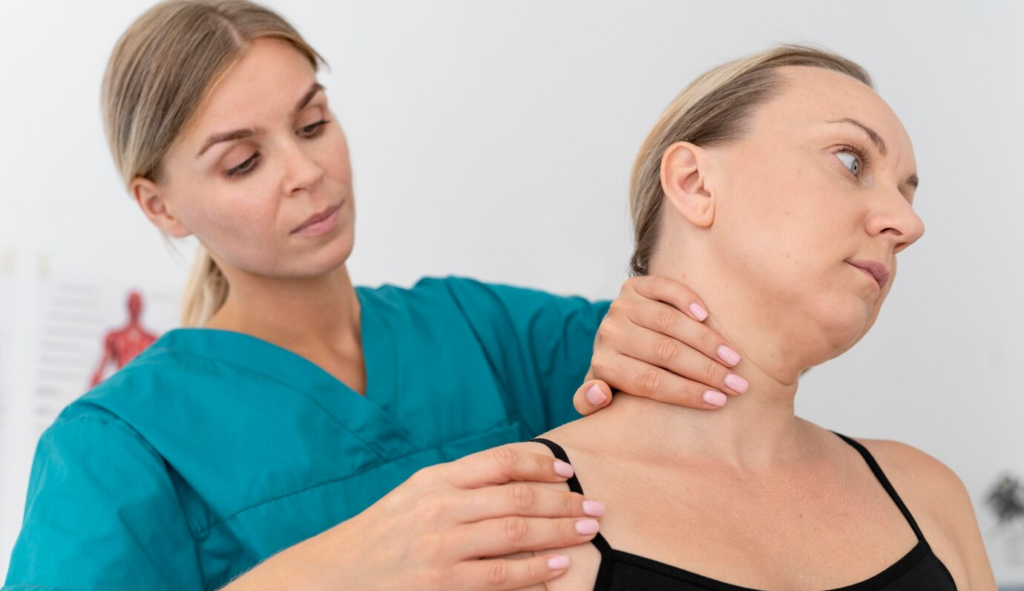

Pinched nerves in the neck are a common ailment that causes pain in the neck, scapula, and arm. It can limit people’s ability to turn their head, look up and can cause numbness, pins and needles and weakness in the arms. When pinched nerves in the neck that cause arm symptoms, it is called cervical radiculopathy. This blog post is designed to help you understand the causes and treatment of cervical radiculopathy.
Cervical radiculopathy causes shoulder blade and arm pain, numbness, tingling and/or weakness that originates from the spinal nerves in the neck. In younger people, such as those under 40 years old, the most common cause of radiculopathy is a disc herniation. Disc herniations happen when the gelatinous center of the disc leaks out from where it is supposed to be and irritates a nerve in the spinal canal. In people over the age of 40, cervical radiculopathy is often because of bone spurs or disc herniations combined with bone spurs. Bone spurs are degenerative bony growth that take place as people age. Just like skin wrinkles as people age, spines develop bone spurs that can narrow the central spinal canal or the location where the nerves exit, called the neuroforamen, and can pinch nerves. This process may cause nerves to dysfunction creating pain, numbness and/or weakness.
Cervical radiculopathy is diagnosed using a clinical history with symptoms in the proper location, triggered by neck movements. Using a physical exam that assesses arm strength, sensation, reflexes, flexibility, and spinal motion. X-rays and an MRI can take detailed pictures of the neck and confirm the clinical diagnosis.
It depends. Cervical disc herniations typically cause symptoms that last weeks to months, and sometimes more. The disc herniation can shrink in size and the nerves can heal. Bone spurs will not shrink in size with time, but the symptoms may improve over weeks to months, but may last a lot longer.
It depends. Usually, it affects just one nerve on one side of the body and can cause localized numbness and weakness. However, it can also present with spinal cord dysfunction called cervical myelopathy. Cervical myelopathy can impair the ability to move hands, walk, balance, and control bowel and bladder. If cervical myelopathy is present, seeking immediate medical care is recommended.
My initial recommendations are to walk for exercise, avoid overhead activities that require prolonged neck extension, do postural exercises, and go to physical therapy. Physical therapy can alleviate pain with postural exercises, such as chin tucks and scapular retraction exercises, and traction. You should seek medical care if cervical radiculopathy limits function, causes weakness, or continues to be symptomatic.
Cervical traction and postural exercises are often helpful. The initial interventional treatment may be an epidural steroid injection (Sara- hyper link to my website the section on epidural steroid injections). This is moderately low risk procedure that uses live time Xray to guide an injection of steroid and analgesic medicine adjacent to the pinched nerve. Sometimes this treatment is effective and other times it is not. If it is ineffective, it may be time to consider surgical treatments.
The most common surgical interventions for cervical radiculopathy or disc replacement and anterior discectomy and fusion (ACDF). Typically, an orthopedic spine surgeon or neurosurgeon would access the spine from the front of the neck and then remove the disc herniation and associated bone spurs and replace the location where the disc used to be with an artificial disc or a bone plug. Sometimes, the surgery is at 1 level, but other times it can be at 2 levels or more.
It depends. Sometimes, people have severely pinched nerves, are healthy and have an easy surgical option. In this scenario surgery may be used early. Similarly, if people have severe nerve damage, such as weakness or cervical myelopathy, early surgical intervention is indicated. Other times, the surgical option is extensive and invasive, or a person has significant medical issues and surgery should be used as a last resort.
Pinched nerves in the neck are common and can cause cervical radiculopathy. Cervical radiculopathy is a common ailment that can cause neck, scapular and arm symptoms including pain, numbness, tingling, and weakness. Nonsurgical options include postural exercises, activity modification, physical therapy, and epidural steroid injections. Surgical options include disc replacement and spinal fusion. Surgical decisions are based upon the severity of illness, personal health factors, and the level of invasiveness of the potential surgery. Seeking professional medical advice is indicated for this condition.